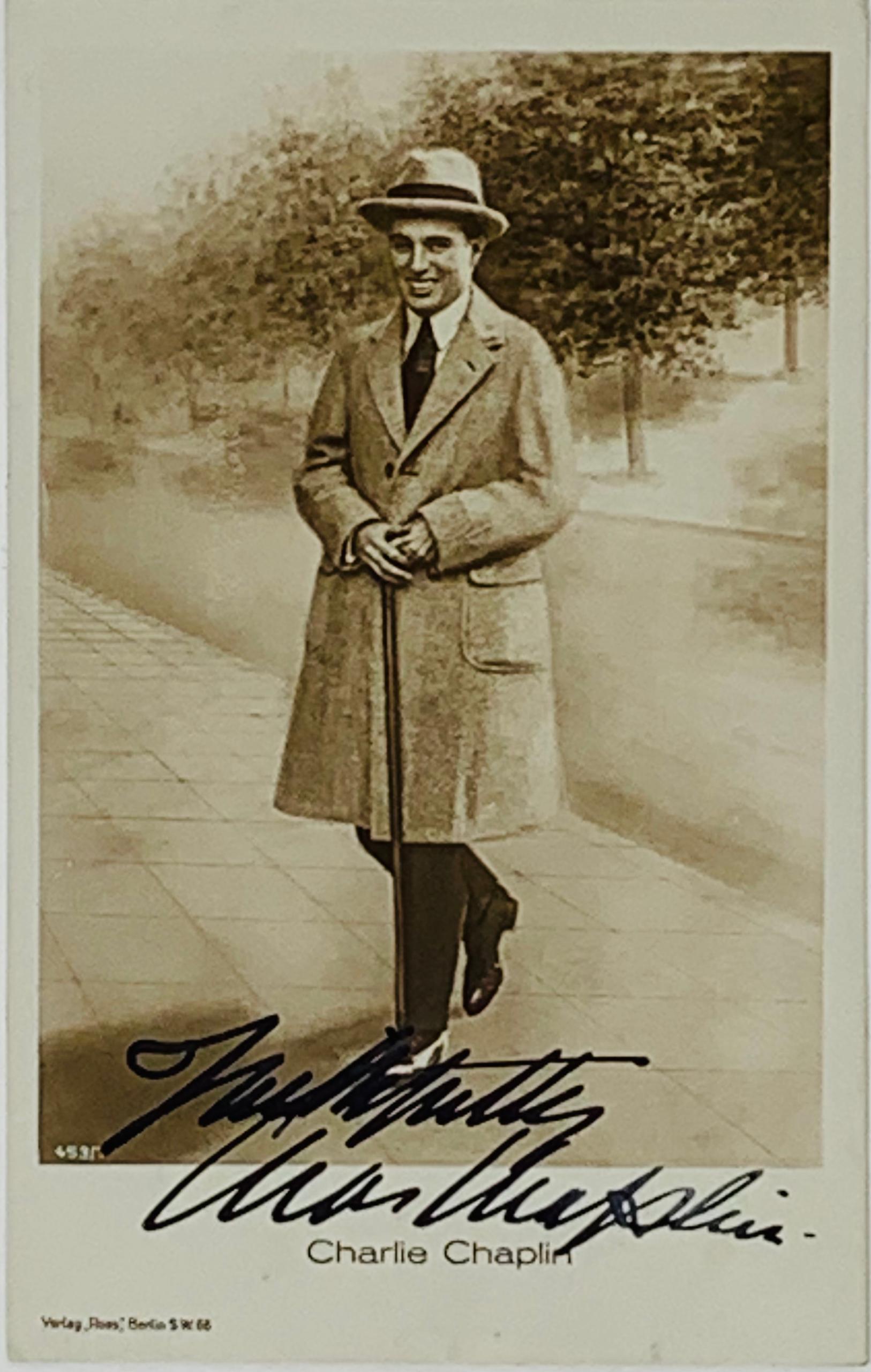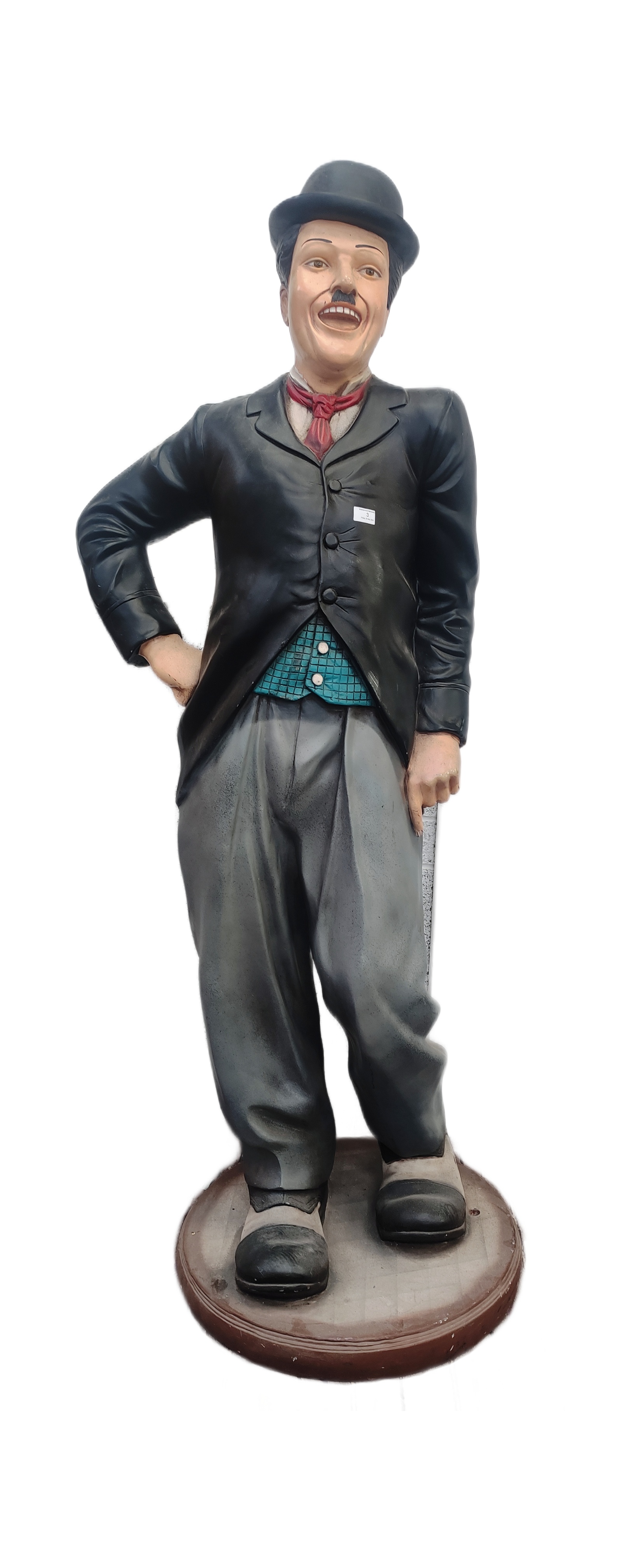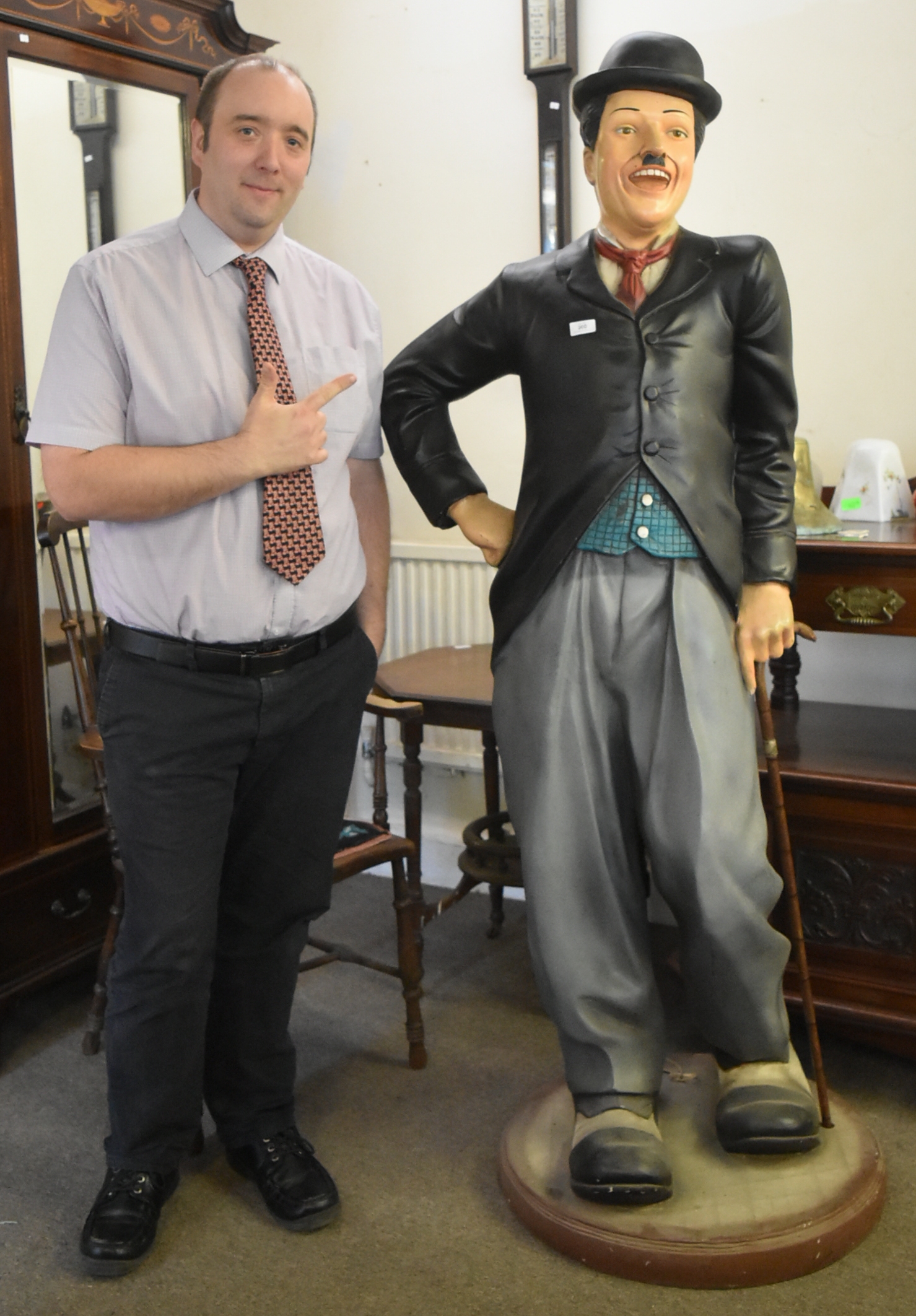CHAPLIN, Sir Charles Spencer [‘Charlie’] (1889-1977). A Whangee cane, 82cm. in length (some chips, and slight wear to base), mounted in a contemporary black-painted wood frame with applied figure of a spanner at the corners, and with white metal display plaque engraved: ‘Presented to the Tivoli Cinema London UK Modern Times 1936’ (red ‘velvet’ case lining renewed, later cardboard backing).
CHAPLIN, Sir Charles Spencer [‘Charlie’] (1889-1977). A Whangee cane, 82cm. in length (some chips, and slight wear to base), mounted in a contemporary black-painted wood frame with applied figure of a spanner at the corners, and with white metal display plaque engraved: ‘Presented to the Tivoli Cinema London UK Modern Times 1936’ (red ‘velvet’ case lining renewed, later cardboard backing). Provenance : Tivoli cinema, the Strand, London, presented by the Chaplin studio to celebrate the opening of Modern Times , thought to have been displayed in the cinema foyer together with four chairs used by royalty -- the cane and chairs purchased from the Tivoli after the war by Sir Montague Morris Burton (1885-1952), founder of the tailoring chain, and donated to a charity – the cane sold by the charity to Cyril Critchlow (d. 2008), and displayed at his Film and Entertainment Museum, Coronation Theatre, Blackpool – purchased by William Forbes-Hamilton and displayed at his Museum of Entertainment in Truro, Cornwall. Later exhibited at the Prince Albert Museum Exeter and the Bill Douglas Cinema Museum, Exeter University. Also exhibited in Paris 2002-03. Sold by Francis Smith Chelsea, 24 September 2013, lot 78, to: Henry Blofeld (early provenance details supplied by William Forbes-Hamilton). AN ORIGINAL ‘CHARLIE CHAPLIN’ BADINE CANE. Although there is no explicit statement on the silver plaque, it seems a reasonable assumption that the cane on display for the London premier of Modern Times was one of those used in the United Artists’ film. Portraying Chaplin as a factory worker employed on an assembly line, this premiered in New York on 5 February, in London on 11 February 1936; it marks Chaplin’s last screen appearance as the Little Tramp. The actor undoubtedly used a number of canes in each of the films featuring his famous tramp costume. They could wear down at the tip or break, curving and snapping as he put weight on them, or getting trapped and broken by such obstacles as swing doors or factory wheels. Another cane from the same film, given by Chaplin to Maurice Bessy in 1947, was sold by Christie’s South Kensington, sale 5515, 14 December 2004, lot 66. Apart from being slightly different heights the two canes appear indistinguishable. Whereas K.S. Ranjitsinhji’s cane (lot 236) was a mark of his opulence, Charlie Chaplin’s cane was important as his only remaining possession. Maurice Bessy writes: ‘The character of Charlie is not a comic character. His shabby clothes are those of a man who is down on his luck. The cane is a mark of snobbishness. It is the sole remaining personal possession of this unfortunate fellow, and that is why he flourishes it with such pride’ ( Charlie Chaplin , London, 1985, p.29). The present cane is sold with the Tivoli Magazine Programme (London, 1936) presenting Modern Times, front wrapper with design of Chaplin with cane and in bowler hat; also sold with a non-vintage photograph of Chaplin in tramp costume.
CHAPLIN, Sir Charles Spencer [‘Charlie’] (1889-1977). A Whangee cane, 82cm. in length (some chips, and slight wear to base), mounted in a contemporary black-painted wood frame with applied figure of a spanner at the corners, and with white metal display plaque engraved: ‘Presented to the Tivoli Cinema London UK Modern Times 1936’ (red ‘velvet’ case lining renewed, later cardboard backing).
CHAPLIN, Sir Charles Spencer [‘Charlie’] (1889-1977). A Whangee cane, 82cm. in length (some chips, and slight wear to base), mounted in a contemporary black-painted wood frame with applied figure of a spanner at the corners, and with white metal display plaque engraved: ‘Presented to the Tivoli Cinema London UK Modern Times 1936’ (red ‘velvet’ case lining renewed, later cardboard backing). Provenance : Tivoli cinema, the Strand, London, presented by the Chaplin studio to celebrate the opening of Modern Times , thought to have been displayed in the cinema foyer together with four chairs used by royalty -- the cane and chairs purchased from the Tivoli after the war by Sir Montague Morris Burton (1885-1952), founder of the tailoring chain, and donated to a charity – the cane sold by the charity to Cyril Critchlow (d. 2008), and displayed at his Film and Entertainment Museum, Coronation Theatre, Blackpool – purchased by William Forbes-Hamilton and displayed at his Museum of Entertainment in Truro, Cornwall. Later exhibited at the Prince Albert Museum Exeter and the Bill Douglas Cinema Museum, Exeter University. Also exhibited in Paris 2002-03. Sold by Francis Smith Chelsea, 24 September 2013, lot 78, to: Henry Blofeld (early provenance details supplied by William Forbes-Hamilton). AN ORIGINAL ‘CHARLIE CHAPLIN’ BADINE CANE. Although there is no explicit statement on the silver plaque, it seems a reasonable assumption that the cane on display for the London premier of Modern Times was one of those used in the United Artists’ film. Portraying Chaplin as a factory worker employed on an assembly line, this premiered in New York on 5 February, in London on 11 February 1936; it marks Chaplin’s last screen appearance as the Little Tramp. The actor undoubtedly used a number of canes in each of the films featuring his famous tramp costume. They could wear down at the tip or break, curving and snapping as he put weight on them, or getting trapped and broken by such obstacles as swing doors or factory wheels. Another cane from the same film, given by Chaplin to Maurice Bessy in 1947, was sold by Christie’s South Kensington, sale 5515, 14 December 2004, lot 66. Apart from being slightly different heights the two canes appear indistinguishable. Whereas K.S. Ranjitsinhji’s cane (lot 236) was a mark of his opulence, Charlie Chaplin’s cane was important as his only remaining possession. Maurice Bessy writes: ‘The character of Charlie is not a comic character. His shabby clothes are those of a man who is down on his luck. The cane is a mark of snobbishness. It is the sole remaining personal possession of this unfortunate fellow, and that is why he flourishes it with such pride’ ( Charlie Chaplin , London, 1985, p.29). The present cane is sold with the Tivoli Magazine Programme (London, 1936) presenting Modern Times, front wrapper with design of Chaplin with cane and in bowler hat; also sold with a non-vintage photograph of Chaplin in tramp costume.
.jpg)








Try LotSearch and its premium features for 7 days - without any costs!
Be notified automatically about new items in upcoming auctions.
Create an alert